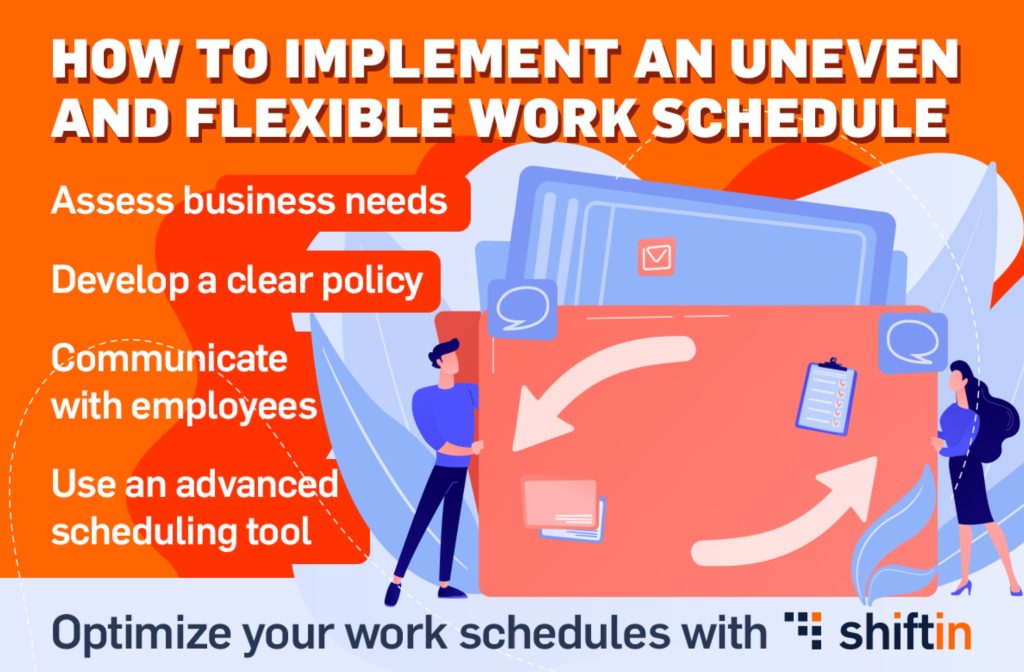- The differences between uneven and flexible working
- Benefits of unequal and flexible working hours for companies
- Implement uneven and flexible working hours
- Legal issues and regulations
- Using shiftin for scheduling
Companies in industries such as healthcare, transportation, manufacturing, retail and hospitality are constantly looking for ways to increase productivity while ensuring employee satisfaction. One innovative approach that has gained popularity in these sectors is adopting an uneven and flexible work schedule. This article explores how to implement such a program, the benefits it brings, and the issues companies in these industries need to consider.
The differences between uneven and flexible working
Before looking at implementation and benefits, it is essential to understand the difference between uneven and flexible work schedules.
Uneven work schedules refer to a work pattern in which employees do not work the same number of hours each day or week. For example, an employee may work more hours one day and fewer on another. This type of schedule allows for variations according to workload and personal needs.
Flexible work schedules, on the other hand, give employees the freedom to choose their working hours within certain limits. Although they may be required to work a certain number of hours per week, the exact timing of these hours is left to them. Combining these approaches can lead to a system of uneven and flexible working hours that maximizes both employee autonomy and company efficiency.
Benefits of unequal and flexible working hours for companies
Implementing unequal and flexible working hours can bring numerous benefits to companies:
Increased productivity
Employees who have control over their schedule are more likely to work during their most productive hours. This can lead to higher output and better quality of work.
More efficient allocation of resources
Uneven and flexible working hours allow companies to allocate staff during peak hours, ensuring efficient use of resources. This is particularly beneficial in industries with fluctuating demand.
Reduced costs
With employees working uneven hours, companies can reduce the need for overtime payments and optimize the use of office space and resources, which can lead to cost savings.

Implement uneven and flexible working hours
Moving to a system of uneven and flexible working hours requires careful planning and communication. Here are the steps to ensure a smooth implementation:
Assess business needs
Determine which departments or roles would benefit most from uneven and flexible work hours. Consider factors such as workload fluctuations and employee preferences.
Create clear policies
Develop a comprehensive policy outlining how flexible and unequal working hours will be managed. This should include guidelines about core hours, maximum and minimum hours, and how employees can request schedule changes.
Communicate with employees
Make sure employees understand the new system and how it benefits them. Provide training, if needed, and be open to feedback during the transition period.
Legal issues and regulations
While the idea of unequal and flexible work hours is appealing, it is crucial to make sure the program complies with labor laws and regulations. Here are some legal considerations:
Working time regulations
Make sure employees don’t work excessive hours and receive required rest periods. Be aware of any legal limits on working hours in your region.
Equal treatment
Unequal and flexible working hours should not lead to discrimination. All employees should have equal access to flexible working arrangements unless specific business reasons justify otherwise.
Contractual obligations
Review and, if necessary, update employment contracts to reflect new working arrangements. Ensure that any changes are mutually agreed between employer and employee.
Record keeping: Keep accurate records of hours worked by employees to ensure compliance with legal requirements and to protect the company in the event of disputes.
Using shiftin for scheduling
To successfully implement and manage uneven and flexible working hours, companies can use specialized tools like shiftin. shiftin is a complete solution for work schedule planning that offers:
Automatic scheduling
Shiftin allows you to easily create and manage uneven work schedules. It takes into account employee availability, business needs and legal requirements to generate optimal schedules.
Real-time adjustments
With shiftin, you can make real-time adjustments to schedules as business needs change, ensuring your company remains agile and responsive.
Employee portal
Employees can access their programs, request changes and communicate directly with managers through the shiftin platform, improving transparency and collaboration.
Monitor compliance
Shiftin helps you stay compliant with labor laws by tracking working hours and ensuring all legal requirements are being met.
Adopting staggered and flexible working hours can be a game changer for companies looking to increase productivity, improve employee satisfaction and optimize resources. With careful implementation planning and the use of tools such as shiftin, companies can benefit from this modern approach to working hours.





